Stargazing

|
The Polar Constellations |

|
The autumn sky is dominated by the Great Square of Pegasus, four stars that form a huge square in the sky, which you can see if you look almost straight up. See it? The stars are a bit faint, but it's distinctive because it's in a faint portion of the sky. The earth has swung around the sun to the southern face of our galaxy so we are now looking out of the disk of the galaxy towards its south pole. As a result, the region of the Great Square has few nearby bright stars. If you follow a straight line through the two stars on the right side of the square up over the top of the sky and back down, it takes you to the North Star.
- We start our tour by turning our attention to the North. Anybody recognize
anything? If you're looking for the Big Dipper, it's there, scraping along
the northern horizon. You may only be able to see parts of it over the tops
of the trees. {Trace out the Big Dipper}.
It's really not a constellation, it's what's called an 'asterism', a highly recognizable part of a constellation. The full constellation is Ursa Major, and is hopelessly lost beneath the horizon at this time of the year.
- The Big Dipper is a polar 'constellation' -- one that is very close to the
North Pole. If stars are close enough to the pole they never set below the
horizon and we can see them all year long. Can anyone spot the Pole Star?
How do you find it? That's right, the two stars at the front edge of the
cup are pointer stars and point to the North Star, whose actual name is
Polaris. Go up from the cup to find Polaris.
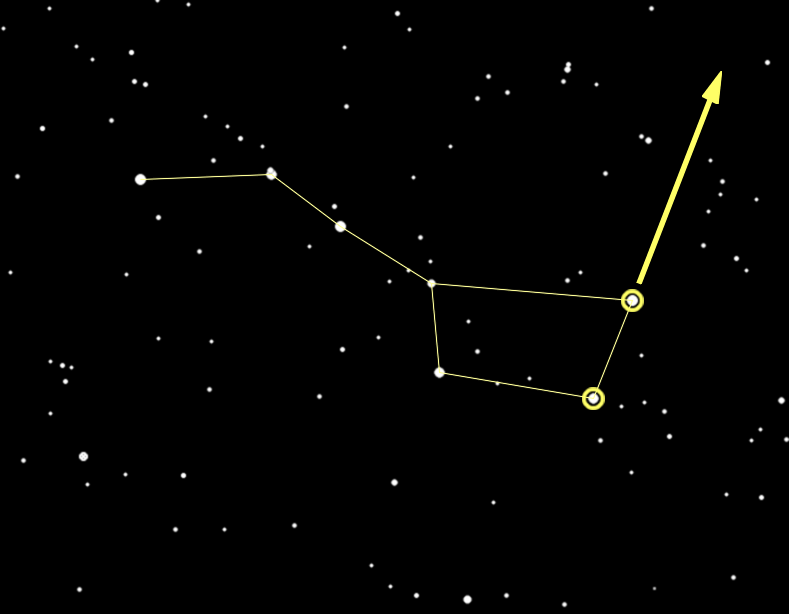
- Since the earth's north pole points to Polaris and the earth rotates around
its poles, all the constellations seem to rotate around Polaris, including
the Big Dipper. You can tell time using the Big Dipper -- it serves as a
24-hour clock.
Click on the little clock here
 for more information.
for more information. - Polaris is a part of the constellation Ursa Minor, more commonly known as
the Little Dipper. Polaris is at the tip of the handle. {Trace out
the Little Dipper.}
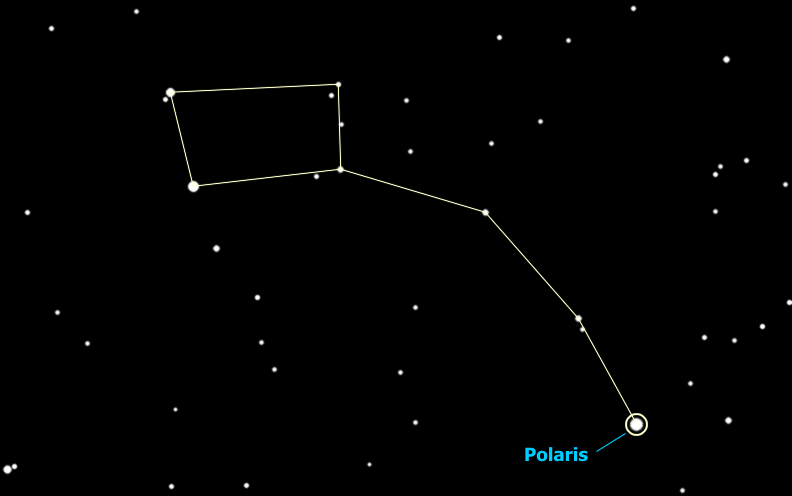
- Threading his way between the Big Dipper and the Little Dipper is
Draco the Dragon. {Trace out Draco.} Draco starts off with two bright
yellow eyes (actually one's yellow, one's orange), and then winds around
the little dipper with its tail between the two dippers. This is a very
cool-looking constellation, a rare one that looks like the monster it is
supposed to be, glaring yellow eyes and all. The head of Draco forms a
distinct asterism, known as "The Lozenge". Who's got the binoculars?
Use them to find Draco's eyes, then go down to find the next star in
the Lozenge closest to the eyes -- ν (nu)
Draconis. Notice anything? That's right, it's a double star, and a
very neat one in binoculars, tight together and exactly equal in
brightness.

- The two most important Polar Constellations to
recognize are the Big Dipper and the Big W, and the Big Dipper is so low
this time of year that it is now even more important to recognize the Big W.
The Big W is Cassiopeia - roughly on the opposite side of Polaris from the
Big Dipper {Trace out Cassiopeia}. Well, it's upside down now so it
looks more like a big "M". Cassiopeia is a Queen in her chair, and even
though this isn't the "official" way to look at her, I envision Cassiopeia's
head at the left side of the "W", making the figure like a lounge chair with
a foot rest. This is how I learned it as a kid, and it's very useful because
you can easily find the North Star by going "Up from the Seat" of Cassiopeia's
chair, in similar manner to going "Up from the Cup" of the Big Dipper. Since
the Big W is on the opposite side of the North Star, this gives you a way to
find Polaris any time of the year, even now when the Dipper likes to hide
below the tree line.
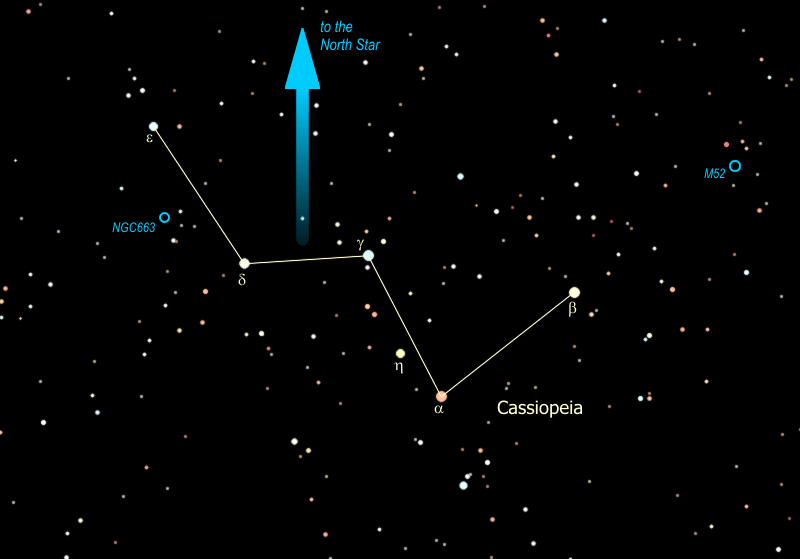
- Cassiopeia got herself into a lot of trouble, leading to the story of
Andromeda and Perseus and involving no less than six constellations in the
sky, the most involved in any of the constellation legends. You'll hear
more about that story in a moment.
- The constellation Cassiopeia lies right smack in
the middle of the Milky Way, and is filled
with galactic clusters, also called open clusters. These are small
groups of stars, maybe a hundred or so, that formed from the same (huge)
cloud of gas and dust. They are very often young stars - blue ones which
are large and very hot and don't last long.
There are several decent examples in Cassiopeia, like Messier object #52, or "M52", one of many "M" objects named after a catalog published in the late 1700's by the Frenchman Charles Messier. Messier was a comet hunter of great renown who published a catalog of fuzzy things that might be confused with comets. These ended up being some of the most interesting objects in the sky. When you find M52 you are looking at a "young"cluster of about 200 stars -- young means that it is only about 100 million years old. The cluster is 10 light years in diameter and 3000 light years away from us, which is why you need the binoculars to see it.Another interesting galactic cluster is NGC 663 (NGC stands for New General Catalog -- published in 1888 it's not really that new). This cluster lies about half way between the two stars on the flattened side of the "W", ε and δ Cassiopeiae. As you sweep the binoculars between the two stars, you will notice that NGC 663 is merely the largest and brightest of several clusters in this region. That may be because it is the closest, at about 3000 light years. The others in that area are 6000 - 8000 light years away. How many clusters can you spot between these two stars? You might be able to see as many as five, with NGC 663 at the center and the other four marking the corners of a diamond around it.
M52 - Note the little box of stars around the cluster NGC 663 - halfway down the left side of the "W" 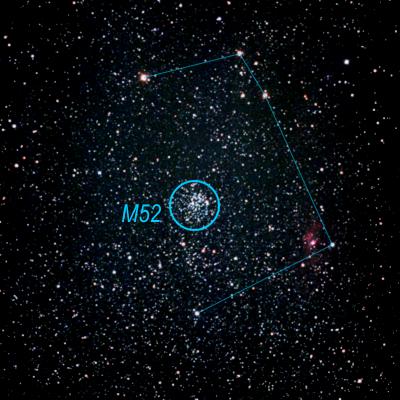
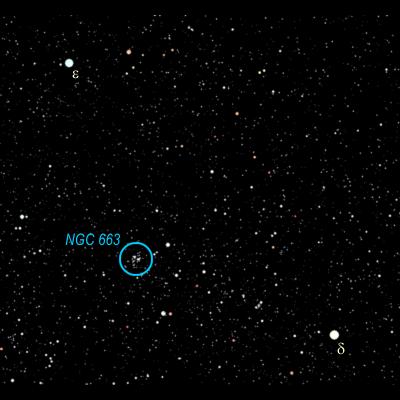
- While you're scoping around for clusters with the binoculars, you notice
anything unusual about the brightest stars of Cassiopeia? They're not
all just points of white light, are they? Some are bright yellow, some
are orange, almost red, and some are blue! There, the one at the center
peak of the W γ Cassiopeiae), that one's blue,
then if you go to the bright one down and to the right α Cassiopeiae),
that one's orange, and the brightest star you see
between those two (η Cassiopeiae), that one's
yellow. So what do the star colors mean? Why would one star be blue and
another red?
Yup, that's right. Different colors show different temperatures. So which star color is the hottest? Just like a flame, blue is the hottest part, yellow is next, red is the coolest. The sun is a yellow star, about 10,000°F at the surface. A red star is about half the sun's surface temperature, whereas a blue star is three to five times as hot as the sun. White stars are somewhere between the yellow ones and blue ones.
Now, all stars are made of pretty much the same stuff -- about 90% hydrogen and the rest is helium with some traces of other stuff. So, why would one star be burning hotter than another? The answer is in the size of the star. The more massive it is, the more pressure there is at the center and therefore the hotter - and for that matter the brighter - the star burns. So blue stars are the biggest and brightest of stars, and red stars are the smallest and dimmest.
So why is red α Cassiopeiae so bright? Hmmm... yeah... well, like with most rules, there are exceptions to the rule, and this rule is no exception. α Cassiopeiae is a star that is literally running out of gas. As a star burns up all the hydrogen at its center, it starts to burn helium (which is the "ash" from the hydrogen burning), which makes it expand, get brighter, and turn red -- it becomes a red giant. This is the time you can get a bright red star, when the star is near the end of its life.
When our sun starts burning out it will expand so big it will swallow up Mercury and Venus and scorch the surface of the earth to a cinder. If you are hoping to see all that happen you will have to wait about 5 billion years.
So there are two reasons a star could be red -- it is massive (and once was yellow, white or even blue) and is now burning out (a red giant), or it never had enough mass to burn any hotter than red (a red dwarf).
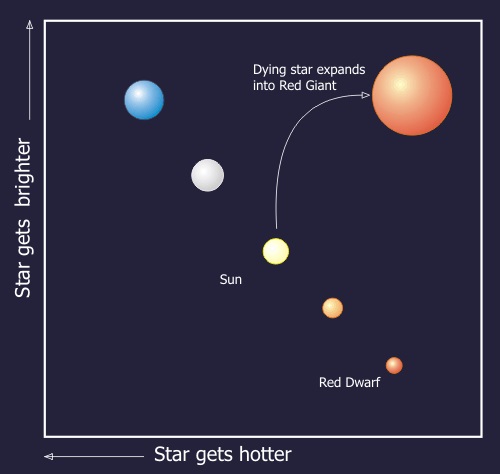
Notice that when we graph out the stars showing their temperature (or color) against their brightness, most of them fall along a line -- this line is called the Main Sequence, and the graph is called the "H-R" (for Hertzsprung-Russell) Diagram. Others are not on the main sequence, mostly stars that are either just being born (called "T-Tauri" stars) or stars that are near the end of life.
- So the Big Dipper points out the North Star, and the three stars of the
handle are pointers as well, but the stars they point to, while important,
are below the horizon right now. Wait a minute is that really three stars
in the Dipper's handle or is it four? Looky there the middle star seems
to have a companion -- the bright star is Mizar and the companion is Alcor.
Who can see the companion?
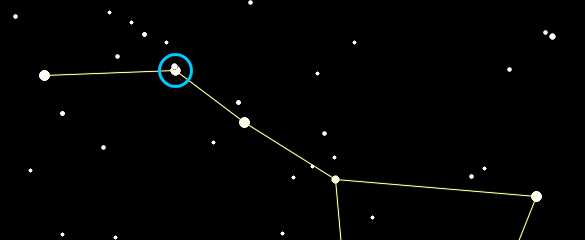
That was used by ancient Greek and Arab armies as an eye test. Some see them as a horse & rider. The Europeans saw the handle of the dipper as the tail of the Great Bear. Since bears don't have tails they danced around it by explaining that when the gods lifted the bear to the sky the tail got stretched out. Pretty lame. The Indians, who knew darn right well that bears don't have tails, saw the three stars of the handle as hunters chasing the great bear (interesting that they also saw a bear). When the constellation Ursa Major sets in the fall, the Indians explained that the hunters catch up with him and shoot him with their arrows, which is why the leaves on the trees turn red. Anyway the three stars are hunters and one of them brought his dog, so Mizar is a hunter and Alcor is his dog. Or another story is that there are three hunters pursuing the bear and one brought a pot to cook the bear in (optimistic). So Mizar is a hunter and Alcor is his pot. Yet another story involves the Pleiades. This is a star cluster in the constellation Taurus (a winter constellation -- we may see them a little later tonight). It is called "the Seven Sisters" and those with very sharp eyes can see seven stars but most people can only see six. So the story is that Mizar is riding off with the Seventh Sister.

 |
 |
 |
| Back to Stargazing | Go to Autumn Index | On to the Milky Way |
Questions
Your questions and comments regarding the Stargazing section are welcome.
You can e-mail the author, Randy Culp for inquiries,
suggestions, new ideas or just to chat.
Updated 18 July 2023
